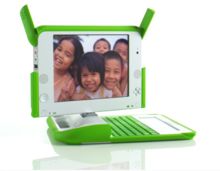Intel Joins the One Laptop Per Child Project
 Intel has been getting a deserved black eye by opposing Nicholas Negroponte's "One Laptop Per Child" (OLPC) project. So they've decided to join up:
Intel has been getting a deserved black eye by opposing Nicholas Negroponte's "One Laptop Per Child" (OLPC) project. So they've decided to join up:
Intel on Friday said it would back the One Laptop per Child effort, the non-profit programme designed to manufacture and distribute $100 laptops to poor children around the world.The move, announced in a joint statement by OLPC and Intel, came just months after Intel Chairman Craig Barrett dismissed the OLPC device as a "gadget" and was accused by OLPC of undercutting its efforts by launching a cheap rival called Classmate, priced at around $200.
These laptops are powered by AMD, so how is Intel going to help?
Intel and OLPC will "explore collaborations involving technology and educational content" the companies said.
This is corporate-speak for "Intel chips will power the servers that run the OLPC system and back up data from individual computers." There's also this:
"Intel joins the OLPC board as a world leader in technology, helping reach the world's children. Collaboration with Intel means that the maximum number of laptops will reach children," said Nicholas Negroponte, founder of One Laptop per Child.
Intel's mere stamp of approval is valuable to OLPC. But this move is even better for Intel. It gets to look good helping a worthy cause. It gets its foot in the door to later put "Intel Inside" what could possibly become a huge market. And, for now, its not even abandoning its rival "Classmate" project.
This move is bad news only for AMD. You have to give AMD credit for trying to put a good face on it:
"Intel's apparent change of heart is welcome, and we're sure they can make a positive contribution to this very worthy project for the benefit of children all over the world."
I love that "apparent change of heart" language. AMD hates this. And they probably feel a little betrayed by the rest of the OLPC board, but can't come out and say it.
UPDATE:
I missed the most obvious benefit OLPC will see from this - a potential bidding war between AMD and Intel for future versions.
I should also renew my call that a commercial version of this machine be released in developed countries. It could help close the digital divide between rich and poor everywhere, it could improve education everywhere, it could improve the world community by giving kids everywhere something in common, it could improve economies of scale, and by pricing it higher in developed countries it could give those customers an opportunity to contribute to the project.
UPDATE 2:
Good news - well, it was news to me anyway:
Michael Wang, Quanta’s president [Quanta is the company manufacturing the OLPC], said on [March 27, 2007] that the concepts developed through the OLPC project could be applied to create commercially viable machines that are cheaper than anything on the market so far.“We will definitely at the right time launch a commercialised product similar to the OLPC,” he said in an interview with the Financial Times, adding that several of Quanta’s customers were seeking to launch such a product.
Quanta designs and manufactures the computers sold by the world’s largest branded companies, including HP, Dell and Acer.
...
But Mr Wang said the low-cost machines would not remain limited to developing markets. “There are a lot of poor people in developed countries, too,” he said.
Yes there is. There's also a sizable middle class that would like to give their kids an OLPC laptop. I could easily imagine some company like Fisher Price or Leap Pad jumping on this.
Quanta has now created a new business unit for “emerging PCs” with the explicit aim of creating a new market for the low-cost machines.He said the cheapest models were likely to be sold without hard disks, have small screens and run on open-source software, like the OLPC version.
Alvin Kwock, an analyst at JP Morgan in Taipei, said:
“OLPC has kick-started a debate over the question: What is needed in a PC?” He estimated that the new ultra-low-cost machines could expand the global PC market, which now measures 250m units a year, by as much as 10 per cent.


